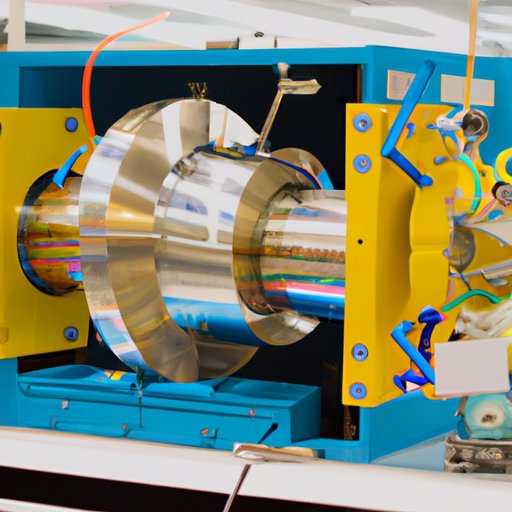Introduction
Particle accelerators are devices that use electromagnetic fields to accelerate charged particles to extremely high speeds. They can be used to study the fundamental structure of matter, analyze the properties of subatomic particles, and explore the mysteries of the universe. In this article, we will take a closer look at how particle accelerators work, what they do, and the science behind them.
A Step-by-Step Guide to Understanding the Physics Behind Particle Accelerators
The basics of particle acceleration involve using electric fields to accelerate charged particles, such as electrons and protons. This is done by applying a voltage difference between two points in space, which creates an electric field. When a charged particle enters this field, it experiences a force that causes it to accelerate. The higher the voltage difference, the greater the acceleration.
In order to understand how particle accelerators work, we must first take a look at the components that make up these devices. Generally speaking, particle accelerators consist of three main parts: a source of charged particles, an accelerator cavity, and a detector. The source provides the initial particles that are to be accelerated, while the accelerator cavity is where the particles are actually accelerated. Finally, the detector records the results of the experiment.
Next, we will explore the process of accelerating particles within a particle accelerator. This is typically done through a series of alternating electric and magnetic fields. As the particles enter the field, they experience a force that causes them to accelerate. This process is repeated multiple times as the particles travel down the length of the accelerator. By the time they reach the end, they are travelling at nearly the speed of light.
Unveiling the Mysteries of Particle Accelerators: How Do They Function?
In order to better understand how particle accelerators work, we must examine the principles that make them function. These principles include the conservation of energy and momentum, the relativistic mass increase, and the Lorentz force. All of these concepts play a key role in determining how particles are accelerated in a particle accelerator.
Particle accelerators are used extensively in scientific research, from studies of basic particles to medical applications. They allow scientists to study the properties of particles at incredibly small scales, which can provide insights into the fundamental nature of the universe. Additionally, particle accelerators can be used to create high-energy beams for medical treatments and other practical applications.
The Basics of Particle Accelerator Technology: How It Works and What It Does
Particle accelerators come in a variety of types, ranging from small tabletop models to large multi-million dollar facilities. Some of the most common types of particle accelerators include linear accelerators, cyclotrons, and synchrotrons. Each type of accelerator has its own unique advantages and disadvantages.
The benefits of particle accelerators are numerous. They allow scientists to probe the smallest particles ever observed, providing new insights into the building blocks of matter. Additionally, particle accelerators are used to produce radiation for medical treatments, allowing doctors to target tumors with pinpoint accuracy. Finally, particle accelerators have even been used to create antimatter, which could potentially revolutionize the way we think about energy production.
The Science Behind Particle Accelerators: How Do They Generate High Energy Particles?
At the heart of particle accelerator technology is the science of particle acceleration. This involves understanding the physics of particle motion and the methods used to accelerate particles. Generally speaking, there are two main ways to accelerate particles: electric fields and magnetic fields. Electric fields use voltage differences to accelerate particles, while magnetic fields use changing magnetic fields to cause particles to move in circles.
Particle accelerators are also used to generate high-energy particles. This is done by increasing the particles’ kinetic energy, or the energy associated with their motion. This is typically accomplished by accelerating the particles in a series of electric and magnetic fields. By the time the particles reach the end of the accelerator, they are travelling at nearly the speed of light and possess an immense amount of energy.
Particle accelerators have a wide range of practical applications. They are used to produce radiation for medical treatments, create antimatter for energy production, and study the fundamental building blocks of matter. Additionally, particle accelerators are used to study the properties of subatomic particles and explore the mysteries of the universe.
Conclusion
Particle accelerators are powerful devices that use electric and magnetic fields to accelerate charged particles to incredibly high speeds. By understanding the principles of particle acceleration and the components of a particle accelerator, we can begin to unravel the mysteries of the universe and explore the possibilities of particle accelerator technology. From medical treatments to energy production, particle accelerators offer a wealth of potential applications that could revolutionize the way we live and work.
(Note: Is this article not meeting your expectations? Do you have knowledge or insights to share? Unlock new opportunities and expand your reach by joining our authors team. Click Registration to join us and share your expertise with our readers.)
